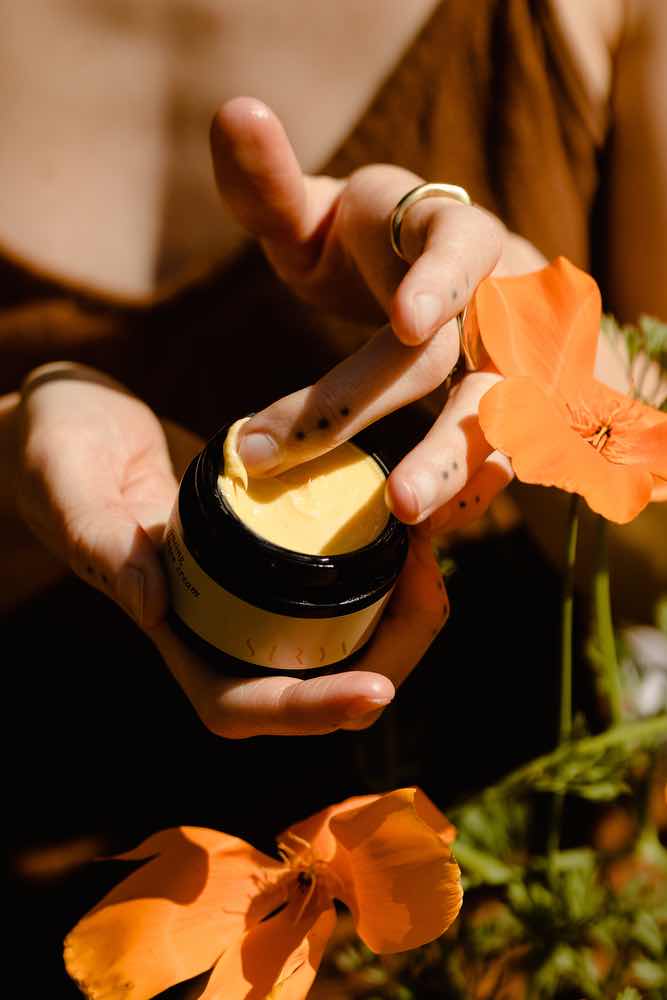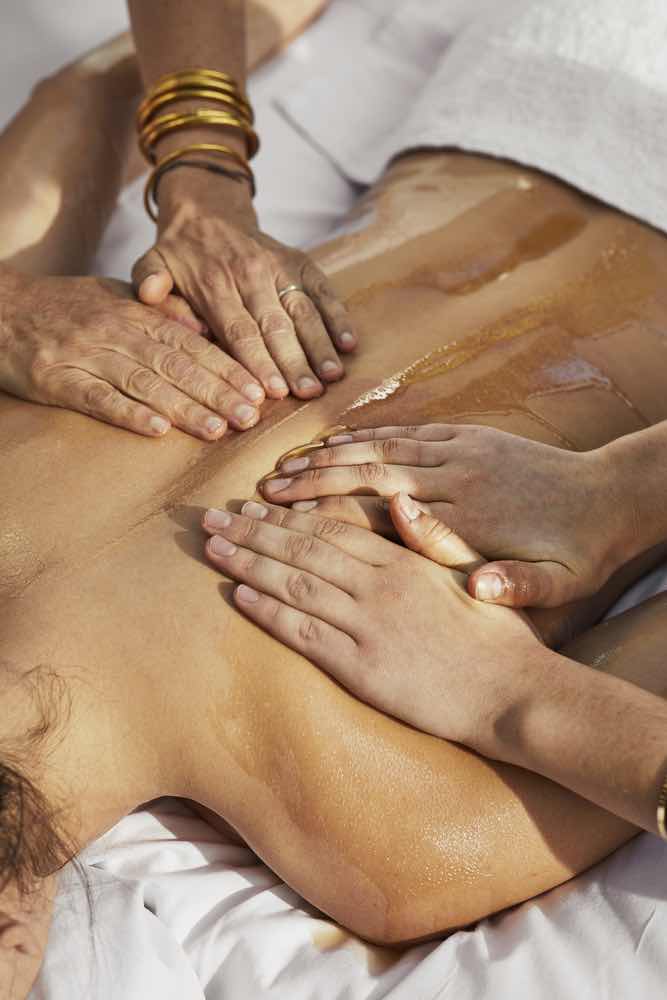
vie-magazine-surya-spa-hero
Bringing Ancient Wisdom to the Modern World
January 2025
The Surya Spa Experience
By Hailey Bethke | Photography courtesy of Surya Spa
Step inside Surya Spa, and you’ll immediately feel a shift to a slower, kinder, and more intentional pace. Upon entry, you may notice the smell of steaming kitchari bubbling in the kitchen, a traditional Ayurvedic comfort food prepared with basmati rice and yellow split mung bean dahl. Chocolate-brown tiles decorate the far wall, where Surya’s extensive product line adorns the shelves. Complete with a warm greeting from the Surya team, the space offers a mutual understanding that this is your time to soften and surrender into tender care.
Headed by world-renowned Ayurvedic Panchakarma expert, Ayurvedic chef, herbal Rasayanist, and master Ayurvedic pulse diagnostician Martha Soffer, Surya Spa brings ancient wisdom to the modern world. “In Sanskrit, ‘ayur’ means life, and ‘veda’ means science,” Soffer explains. “So, Ayurveda is the science of life. It’s a holistic way of helping people live more easefully at any age.”
After working one-on-one with Soffer and experiencing Surya’s renowned Abhayanga four-handed massage, I can attest that her expertise and each treatment are exceptional. While I hope you have an opportunity to visit Surya Spa in Santa Monica, California, this interview offers a valuable introduction to Ayurvedic philosophies and how to honor your body’s natural cycles and rhythms throughout life. Whether you’re new to the Ayurveda concept or want to live in alignment with your doshas, we hope this piece inspires you to connect to your body’s innate wisdom.
Ayurveda consists of three principles, called doshas, which correlate to the elements. They are Vata, Pitta, and Kapha. These Sanskrit words may be confusing, especially if you’re hearing them for the first time, so Soffer likes to add a descriptive term to each one. Vata (the wind element) needs calming, Pitta (the fire element) needs cooling, and Kapha (the water and earth elements) needs energizing.
Each of us contains a unique combination of Vata, Pitta, and Kapha, determined by the quantities of these doshas within both parents. You will always be your dosha or your dosha combination, although your doshic balances and imbalances will inevitably shift throughout your life. For example, even if you are Pitta Vata, you can still struggle with excessive Kapha levels that must be brought back into equilibrium.
“Every time someone comes to me and wants to get pregnant, I always suggest Panchakarma so we can cleanse the tissues and the body of any excess Pitta, Kapha, and Vata,” Soffer explains. She says when the mother’s and the father’s bodies are balanced, you’ll conceive a child that has balanced levels of each element—balance at the beginning of this new life. If the dad or the mom has too much Pitta, now the child will have double Pitta. “I think it’s so important to do Panchakarma before you’re planning on bringing a new human life to earth,” she tells me. Panchakarma is a series of Ayurvedic treatments, often performed four times per year at the change of each season, and typically spans seven days. This is Surya’s most revered treatment series and can be completed in one to twenty-eight days, depending on your financial commitment and goals.
Each of the doshas also correlates to a unique season of life. You’re in the Kapha season from the moment you are born to around twelve or thirteen years old. This period is characterized by catching colds because this is the crucial period when your immune system develops. Then, from puberty to age fifty, we enter the Pitta season. Fire is necessary to procreate, and this excess heat explains why young adults struggle with acne. Vata season is post-menopause; your skin starts to dry out, and you may develop more wrinkles. Understanding which season of life you are in and your unique dosha composition will help you bring greater balance to your body; this is only a fraction of the information Soffer looks at when you participate in a cleanse like Panchakarma.
One of the most extraordinary aspects of working with Soffer was understanding one of the languages of the body she uses to diagnose and treat imbalances: Ayurvedic Pulse Diagnosis. This technique involves placing three fingers on your arm to study the characteristics of your pulse. She teaches me that she always reads the right arm for men and the left arm for women. In Ayurveda, there are two holes on either side of the spine that energy is said to flow through; the Ida is on the right side (masculine energy), and the Pingala is on the left (feminine energy).
Ayurvedic Pulse Diagnosis can help you detect illnesses or imbalances in the body before they happen.
For example, I can tell from a pulse if someone has a UTI that is just beginning to show,” Soffer tells me. “It’s like when you start to get a sore throat before you get the cold. But, if you do the right things, like taking a hot shower and getting extra sleep, you can prevent yourself from getting sick.
A quick pulse indicates excess Vata—someone always running from one task to the next and struggling to prioritize self-care. A dense and slow pulse likely means that a patient has cholesterol issues. Ayurvedic Pulse Diagnosis is a highly intricate practice that requires years of dedicated study to master. Yet, Soffer assures me that with experience, interpreting each sensation becomes second nature.
Soffer is particularly passionate about helping women understand their bodies’ innate wisdom. From hormonal imbalances to fertility struggles and chronic acne, she has seen it all when it comes to women’s health. A proponent of cycle syncing, she encourages all women to learn about their bodies’ natural rhythms through basal temperature tracking and balancing work and rest according to the phases of their menstrual cycle.
One of her most valuable tips for alleviating painful periods is to avoid carbohydrates, sugar, caffeine, and chocolate after ovulation, which will prevent cramping. If you indulge in a bowl of pasta, mitigate the impact of carbohydrates on your body (glucose spiking) by eating vegetables first. This will make your carbohydrates easier to digest. Moreover, before your period happens, the amount of Pitta in your body continues to rise. This is why your skin breaks out before your period. She also suggests avoiding spicy foods, tomatoes, and eggplants during this period (the luteal phase).
Soffer understands that modern Ayurveda is not about perfection but balance. Before learning about Ayurveda, she was far from perfect health. “I moved to Los Angeles from Colombia at age twenty-seven to work for IBM in engineering and programming. It was a super stressful job,” she tells me. “I had awful headaches, painful periods, and acid reflux, so I always had a jar of TUMS with me at all times.”
At twenty-seven, Soffer had a serendipitous encounter in the cafeteria of Maharishi International University. She connected with a woman whose hair was still glistening from an Abhyanga treatment—a traditional Ayurvedic four-handed massage—who shared her transformative experience. Intrigued, Soffer explored the Ayurvedic center on campus and experienced Abhyanga along with Shirodhara, a soothing ritual where warm oil is gently poured onto the forehead to calm the nervous system. From that moment, she became deeply devoted to Ayurveda, immersing herself in the study and practice of this profound ancient healing system.
Soffer crafts each product recipe in the Surya collection by hand with meticulous care. When asked which product she would use for the rest of her life, she doesn’t hesitate to answer: the Balancing Face Oil, known affectionately at Surya as “liquid gold.” The story behind this iconic product began in her kitchen, where she first experimented with the formulation. She shared a small jar with a close friend who worked at MAC Cosmetics, who then passed a sample to a colleague at REVLON, after receiving glowing compliments on her radiant skin. Shortly thereafter, the REVLON colleague gently warned her young daughter not to touch the face oil, calling it “liquid gold” as the child played with her makeup. Created fifteen years ago, the Balancing Face Oil remains a best-seller alongside Surya’s Balancing Collagen Cream.
We culminated our interview with a conversation about legacy: Where does she envision her work with Ayurveda going next? “If I die right now, I’ll be happy because I got to expose Ayurveda to people who have never heard of it,” she shares. “So many people are able to walk away with such an incredible experience.”
Having played an essential role in spreading Ayurveda throughout America (and internationally on an increasing level) and working with A-list celebrity clientele, Soffer aims to have even more people experience these transformative treatments firsthand. “It’s so simple to live a healthy, happy life if you apply the principles of Ayurveda,” she concludes.
— V —
To connect with Martha Soffer and the team at Surya Spa, please visit SuryaWellness.com and follow along on Instagram @suryabymartha.
Rapid-Fire Questions with Martha Soffer
What’s your morning routine?
Cold water in my eyes, meditation, tongue scraping, yoga asanas, and drinking 24 ounces of warm water first thing in the morning—sometimes with a little bit of lime and salt.
What’s an undervalued quality that you wish more people would embody?
Self-care
Where is the next place on your travel bucket list?
India
What daily habit has radically transformed your life?
Transcendental meditation
— V —
Share This Story!
KEEP UP WITH THE LATEST STORIES FROM VIE






















































































































































